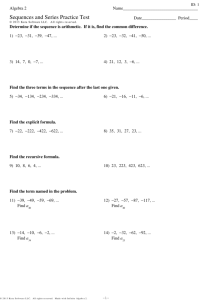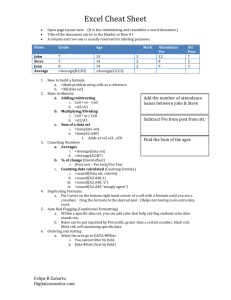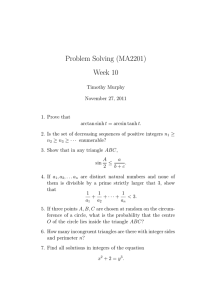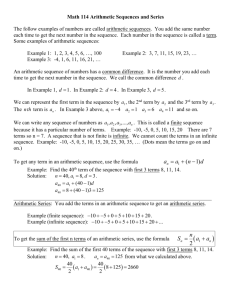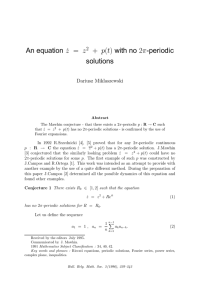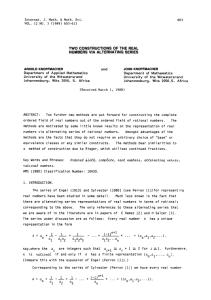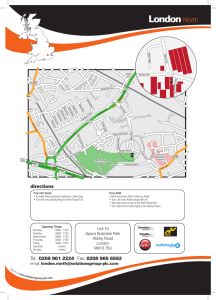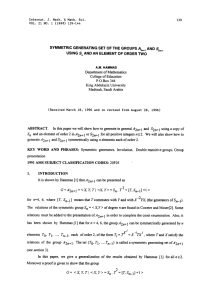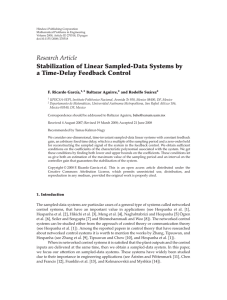Document 10677383
advertisement
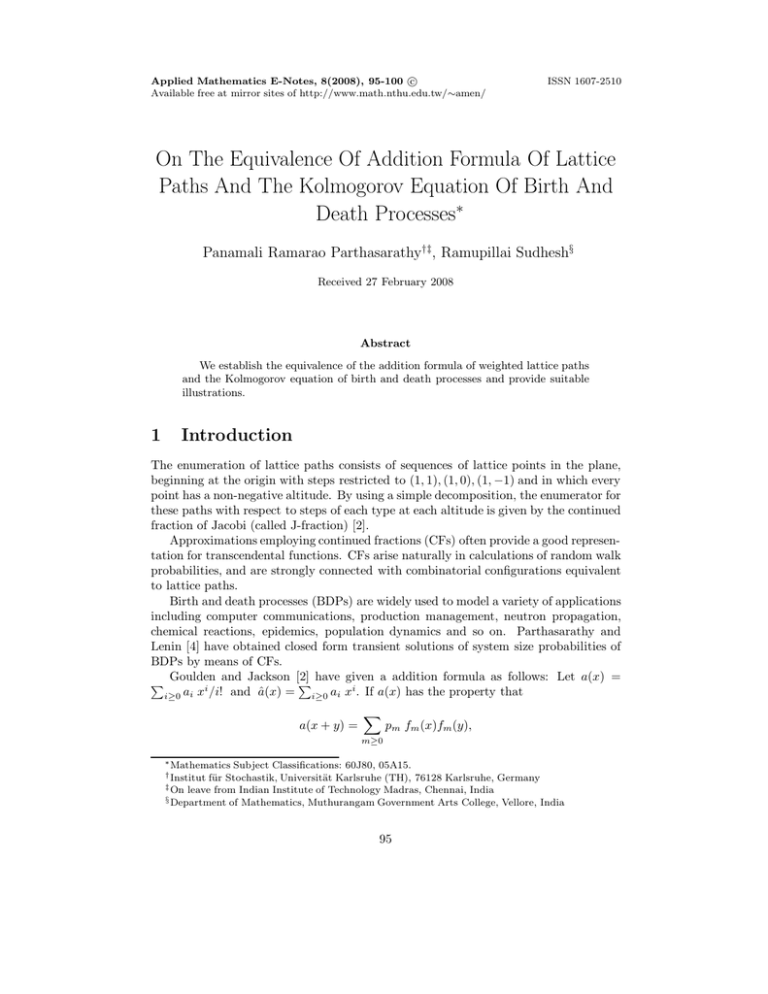
c
Applied Mathematics E-Notes, 8(2008), 95-100 Available free at mirror sites of http://www.math.nthu.edu.tw/∼amen/
ISSN 1607-2510
On The Equivalence Of Addition Formula Of Lattice
Paths And The Kolmogorov Equation Of Birth And
Death Processes∗
Panamali Ramarao Parthasarathy†‡, Ramupillai Sudhesh§
Received 27 February 2008
Abstract
We establish the equivalence of the addition formula of weighted lattice paths
and the Kolmogorov equation of birth and death processes and provide suitable
illustrations.
1
Introduction
The enumeration of lattice paths consists of sequences of lattice points in the plane,
beginning at the origin with steps restricted to (1, 1), (1, 0), (1, −1) and in which every
point has a non-negative altitude. By using a simple decomposition, the enumerator for
these paths with respect to steps of each type at each altitude is given by the continued
fraction of Jacobi (called J-fraction) [2].
Approximations employing continued fractions (CFs) often provide a good representation for transcendental functions. CFs arise naturally in calculations of random walk
probabilities, and are strongly connected with combinatorial configurations equivalent
to lattice paths.
Birth and death processes (BDPs) are widely used to model a variety of applications
including computer communications, production management, neutron propagation,
chemical reactions, epidemics, population dynamics and so on. Parthasarathy and
Lenin [4] have obtained closed form transient solutions of system size probabilities of
BDPs by means of CFs.
and Jackson [2]
a addition formula as follows: Let a(x) =
P Goulden
P have given
i
i
a
x
/i!
and
â(x)
=
a
x
.
If
a(x)
has the property that
i≥0 i
i≥0 i
a(x + y) =
X
pm fm (x)fm (y),
m≥0
∗ Mathematics
Subject Classifications: 60J80, 05A15.
für Stochastik, Universität Karlsruhe (TH), 76128 Karlsruhe, Germany
‡ On leave from Indian Institute of Technology Madras, Chennai, India
§ Department of Mathematics, Muthurangam Government Arts College, Vellore, India
† Institut
95
96
Addition Formula of Lattice Paths
where pm is independent of x and y, and
fm (x) =
xm
xm+1
+ qm+1
+ O(xm+2 )
m!
(m + 1)!
then a(x) has an addition formula with parameters {(pm , qm+1 )|m ≥ 0}. The formal
power series fb(x) has an addition formula with parameters {(pm , qm+1 )| m ≥ 0} if and
only if
1ˆ 1
1
p1 p−1
p2 p−1
0
1
f
=
··· .
(1)
x
x
x − (q1 − q0 )− x − (q2 − q1 )− x − (q3 − q2 )−
where we use the notation for CFs
a1 a2 a3
a1
···=
.
b1 − b2 − b3 −
b1 − b2 −a2a3
b3 −···
They have given a combinatorial proof of this theorem by considering the generating
function for paths of non-negative length from altitude 0 to altitude 0, with respect to
rises and levels.
It is well known that the transition function Pmn (t) = P(X(t) = n|X(0) = m) of
BDPs satisfies the Kolmogorov equation:
X
Pmn (t + u) =
Pmk (t)Pkn (u).
k∈N
This equation states that in order to move from state m to state n in time t + u, X(t)
first moves to some state k in time t and then from k to n in the remaining time u.
In this paper, we present the equivalence of the addition formula of lattice paths and
the Chapman-Kolmogorov equation of birth and death processes. We give examples to
illustrate our result.
2
Birth and Death Processes
A BDP is a continuous time Markov chain {X(t), t ≥ 0} defined on a probability
space (Ω, F , P ) with stationary transition probability Pmn (t) satisfying the forward
Kolmogorov differential equations:
0
Pm0
(t)
0
Pmn
(t)
= −a0 Pm0 (t) + a1 Pm1 (t)
= a2n−2Pm,n−1 (t) − (a2n−1 + a2n )Pmn (t) + a2n+1 Pm,n+1 (t),
(2)
for n = 1, 2, 3, ... . The parameters a2n (n ≥ 0) and a2n−1 (n ≥ 1) are respectively
called the birth and death rates (instead of the usual λn and µn ). The reason for this
notation will become apparent in the sequel.
Let us take Laplace transforms
Z ∞
P̂mn (s) =
e−st Pmn (t)dt, n = 0, 1, 2, . . . ,
0
97
P. R. Parthasarathy and R. Sudhesh
for Re(s) > 0 of the system of equations given by (2). We assume that m = 0, and in
that case P̂00 (s) simplifies to the expression
P̂00 (s) =
1
(s)
P̂
,
s + a0 − a1 P̂01 (s)
00
and
P̂0n(s)
P̂0,n−1 (s)
a2n−2
=
=
(s)
P̂
s + a2n−1 + a2n − a2n+1 0,n+1
P̂0n (s)
a2n−2
a2n a2n+1
a2n+2 a2n+3
·
·
· · · (3)
.
s + a2n−1 + a2n − s + a2n+1 + a2n+2 − s + a2n+3 + a2n+4 −
Using (3),
P̂00(s) =
a0 a1
a2 a3
1
··· .
s + a0 − s + a1 + a2 − s + a3 + a4 −
(4)
We shall now give a fundamental correspondence between the addition formula
and the Kolmogorov equation of a birth-death process. For this, we first refer to the
following theorem of Parthasarathy and Sudhesh [5].
THEOREM 1. If X(0) = m, then the power series representation for the state
probabilities Pmn (t), n = 0, 1, 2, . . ., corresponding to a state-dependent BDP with
birth and death rates respectively a2n and a2n+1 , (0 ≤ n < ∞) are given by
Mm P∞
tr+m−n Pmin(r,n)
(−1)r (r+m−n)!
(−1)k φk (2n + 1)A(r − k, 2m),
r=0
k=0
M
n
n = 0, 1, 2, . . ., m
Pmn (t) =
P
Pmin(r,m)
r tr+n−m
k
LLn−1 ∞
(−1)
(−1)
φ
(2m
+ 1)A(r − k, 2n),
k
k=0
(r+n−m)!
m−1 r=0
n = m, m + 1, ... .
(5)
where L−1 = 1, Ln−1 = a0 a2 a4 · · · a2n−2, M0 = 1, Mn = a1 a3 a5 · · · a2n−1, φ0 (n) =
1, φr (n) = 0 if r ≥ [ n+1
], for r ≥ 1, n = 1, 2, 3, . . .,
2
φr (n + 1) =
n−2r
X
ai 1
i1 =0
and
A(r, n) =
n
X
i1 =0
ai 1
iX
1 +1
ai 2
i2 =0
n−2r+2
X
ai 2
i2 =i1 +2
iX
2 +1
n−2r+4
X
i3 =i2 +2
ai 3 · · ·
n−2
X
ai r ,
(6)
ir =ir−1 +2
ir−1 +1
ai 3 · · ·
i3 =0
X
air , ∀ n ∈ N, A(0, n) = 1.
(7)
ir =0
From (5), we observe that the transition function Pmn (t) satisfies
πm Pmn (t) = πn Pnm(t),
where
π0 ≡ 1, πn ≡
m, n ∈ N , t ≥ 0,
a0 a2 · · · a2n−2
, n = 1, 2, 3, . . .,
a1 a3 · · · a2n−1
(8)
98
Addition Formula of Lattice Paths
are the potential coefficients and (8) shows that Pmn (t) is symmetric. Therefore
{X(t), t ≥ 0} is reversible [1].
THEOREM
probability P00 (t) has an addition formula with
nQ2. The transition
P2m 2m−1
parameters
i=0 ai , −
i=0 ai m ≥ 0}.
PROOF. From (5),
P0m(t) = Lm−1 fm (t),
Pm0 (t) = Mm fm (t),
where
fm (t) =
tm
tm+1
tm+2
tm+3
− A(1, 2m)
+ A(2, 2m)
− A(3, 2m)
+ · · · . (9)
m!
(m + 1)!
(m + 2)!
(m + 3)!
Using the Kolmogorov equation,
P00(t + u) =
∞
X
P0m (t)Pm0 (u) =
m=0
∞
X
pm fm (t)fm (u),
m=0
where
pm =
2m−1
Y
ai .
i=0
From (9),
qm+1 = −A(1, 2m) = −
2m
X
ai .
i=0
Therefore, for m = 0, 1, 2, . . .,
qm+1 − qm = −(a2m−1 + a2m ), a−1 = 0 and pm+1 p−1
m = a2m a2m+1 .
Hence, P00 (t) = f0 (t) has an addition formula with parameters
( 2m−1
!
)
2m
Y
X
ai , −
ai i| m ≥ 0
i=0
i=0
and the corresponding J-fraction coincides with (4).
The following two examples present the addition formula representation of the transition probability P00(t).
EXAMPLE 1 (Linear rates). Consider a BDP with birth and death rates
a2n = a2n+1 = n + 1, n = 0, 1, 2, . . . .
so that
πn = 1,
n = 0, 1, 2, . . ..
The corresponding J-fraction for P̂00 (s) is
P̂00 (s) =
1
12
22
··· =
s + 1− s + 3− s + 5−
Z
0
∞
∞
X
e−t
r!
dt =
(−1)r r+1 ,
s+t
s
r=0
99
P. R. Parthasarathy and R. Sudhesh
[3, p. 582, (4.6.1)].
This leads to the transition probability,
P00 (t) =
From Theorem 1,
P0m (t) =
Using (8),
Pm0 (t) =
1
.
1+t
tm
, m ≥ 0.
(1 + t)m+1
π0
tm
P0m(t) =
.
πm
(1 + t)m+1
Therefore,
P00(t + u) =
∞
∞
X
X
1
=
P0m (t)Pm0 (u) =
(m!)2 fm (t)fm (u),
1+t+u
m=0
where
m=0
2 m+1
1
tm
tm
m+1
t
fm (t) =
=
− 1!
+ O(tm+2 ).
m! (1 + t)m+1
m!
1
(m + 1)!
Hence P00 (t) has an addition formula with parameters {( (m!)2 , −(m + 1)2 )|m ≥ 0}.
EXAMPLE 2 (Infinite sever queue) Consider a BDP with birth and death rates
a2n = 1, n = 0, 1, . . . , and a2n−1 = n, n = 1, 2, . . . ,
so that
1
, n = 0, 1, 2, . . . .
n!
This rates corresponds to the M/M/∞ (self service) model. It is well known that,
πn =
P0m(t) =
Using (8),
(1 − e−t )m exp(e−t − 1)
,
m!
m ≥ 0.
Pm0 (t) = (1 − e−t )m exp(e−t − 1), m ≥ 0.
Therefore,
P00(t + u) = exp[e−(t+u) − 1] =
∞
X
m=0
where
fm (t) =
P0m (t)Pm0 (u) =
∞
X
m!fm (t)fm (u),
m=0
(1 − e−t )n exp(e−t − 1)
tm
(m + 1)(m + 2) tm+1
=
−
+ O(tm+2 ).
m!
m!
2
(m + 1)!
Hence P00 (t) has an addition formula with parameters {(m!, −(m + 1)(m + 2)/2)| m ≥
0}.
Acknowledgment. The first author thanks Professor Norbert Henze, University
of Karlsruhe for his invitation and Deutsche Akademischer Austausch Dienst (DAAD)
for financial assistance during the preparation of the paper.
100
Addition Formula of Lattice Paths
References
[1] W. J. Anderson, Continuous Time Markov Chains - An Application Oriented Approach, Springer-Verlag, New York, 1991.
[2] I. P. Goulden and D. M. Jackson, Combinatorial Enumeration, John Wiley and
Sons, New York, 1983.
[3] L. Lorentzen and H. Waadeland, Continued Fractions with Applications, Studies
in Computational Mathematics, Vol. 3, Elsevier Science, 1992.
[4] P. R. Parthasarathy and R. B. Lenin, Birth and Death Process (BDP) Models with
Applications - Queueing, Communication Systems, Chemical Models, Biological
Models: The State-of-the-Art with a Time-Dependent Perspective, American Series
in Mathematical and Management Sciences Vol. 51, American Sciences Press, Inc.,
Columbus, 2004.
[5] P. R. Parthasarathy and R. Sudhesh, Exact transient solution of state-dependent
birth-death processes, Journal of Applied Mathematics and Stochastic Analysis,
2006 (2006), Article ID 97073, 1-16.


